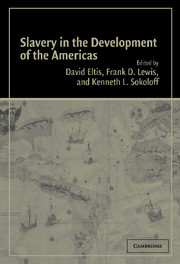Book contents
- Frontmatter
- Contents
- Appreciation: Stanley L. Engerman and Slavery
- Introduction
- PART I ESTABLISHING THE SYSTEM
- PART II PATTERNS OF SLAVE USE
- 3 Mercantile Strategies, Credit Networks, and Labor Supply in the Colonial Chesapeake in Trans-Atlantic Perspective
- 4 African Slavery in the Production of Subsistence Crops the Case of São Paulo in the Nineteenth Century
- 5 The Transition from Slavery to Freedom through Manumission: A Life-Cycle Approach Applied to the United States and Guadeloupe
- PART III PRODUCTIVITY CHANGE AND ITS IMPLICATIONS
- PART IV IMPLICATIONS FOR DISTRIBUTION AND GROWTH
- The Writings of Stanley L. Engerman
- Contributors
- Index
3 - Mercantile Strategies, Credit Networks, and Labor Supply in the Colonial Chesapeake in Trans-Atlantic Perspective
Published online by Cambridge University Press: 18 August 2009
- Frontmatter
- Contents
- Appreciation: Stanley L. Engerman and Slavery
- Introduction
- PART I ESTABLISHING THE SYSTEM
- PART II PATTERNS OF SLAVE USE
- 3 Mercantile Strategies, Credit Networks, and Labor Supply in the Colonial Chesapeake in Trans-Atlantic Perspective
- 4 African Slavery in the Production of Subsistence Crops the Case of São Paulo in the Nineteenth Century
- 5 The Transition from Slavery to Freedom through Manumission: A Life-Cycle Approach Applied to the United States and Guadeloupe
- PART III PRODUCTIVITY CHANGE AND ITS IMPLICATIONS
- PART IV IMPLICATIONS FOR DISTRIBUTION AND GROWTH
- The Writings of Stanley L. Engerman
- Contributors
- Index
Summary
Everyone agrees that bound laborers were brought to the Chesapeake primarily for the purpose of raising tobacco. Consequently it is rather surprising that the eighteenth century scholars have neglected to examine in any detail the relationship between the supply of bound labor and the fortunes of the region's staple. Recently compiled databases on the Chesapeake slave and servant trades, and now information on staple prices, and on tobacco, slave, and servant traders allow us to explore the links for the first time. This essay first reassesses the volume of imported bound laborers, the relationship between staple prices and labor supply, and the interplay between the trades in tobacco and bound laborers. It then examines in greater detail the strategies followed by merchants from Britain's major ports, and the differing terms by which indentured servants, convicts, and slaves were sold in the Chesapeake. Finally it discusses some of the implications for the distribution of bound labor within sub-regions of the Tobacco Coast and among purchasers of varying wealth.
Slaves clearly predominated among bound laborers in the eighteenth century Chesapeake, although there is less agreement about the relative contributions of imports and of natural increase to this result. By the early 1690s slaves outnumbered servants by more than three to one even in Maryland, a colony which was less well supplied with slaves than Virginia throughout the seventeenth century. And by the 1720s indentured servants were no longer a significant component of the bound labor force in most of the region.
- Type
- Chapter
- Information
- Slavery in the Development of the Americas , pp. 89 - 119Publisher: Cambridge University PressPrint publication year: 2004
- 1
- Cited by



